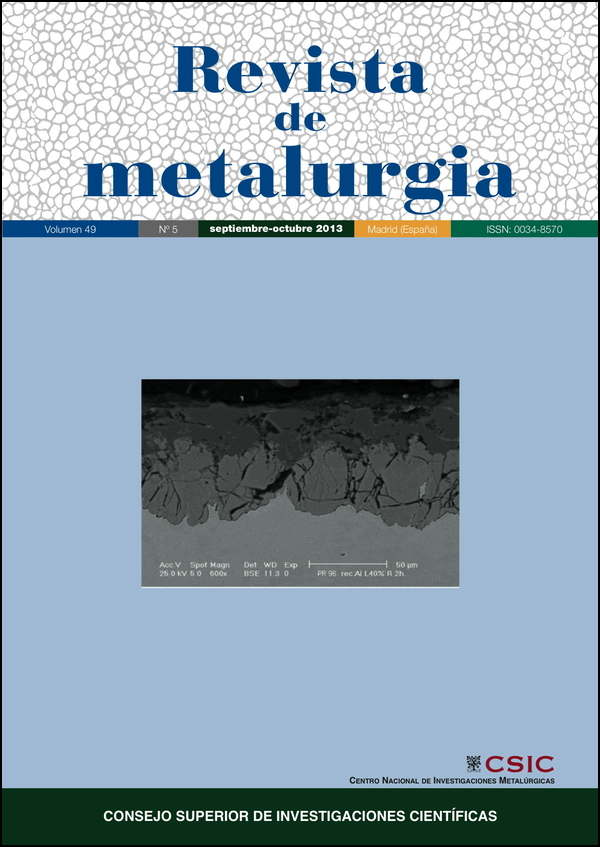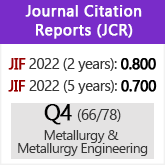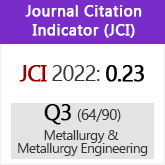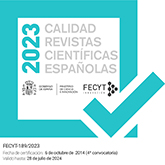Wear resistance of Fe-Nb-Cr-W, Nb, AISI 1020 and AISI 420 coatings produced by thermal spray wire arc
DOI:
https://doi.org/10.3989/revmetalm.1222Keywords:
Wear, Thermal spray, Coatings, 140MXCAbstract
The commercial materials 140MXC (with iron, tungsten, chrome, niobium), 530AS (AISI 1015 steel) and 560AS (AISI 420 steel) on AISI 4340 steel were deposited using thermal spray with arc. The aim of work was to evaluate the best strategy abrasive wear resistance of the system coating-substrate using the following combinations: (1) homogeneous coatings and (2) coatings depositing simultaneously 140MXC + 530AS and 140MXC + 560AS. The coatings microstructure was characterized using Optical microscopy, Scanning electron microscopy and Laser confocal microscopy. The wear resistance was evaluated through dry sand rubber wheel test (DSRW). We found that the wear resistance depends on the quantity of defects and the mechanical properties like hardness. For example, the softer coatings have the biggest wear rates and the failure mode was characterized by plastic deformation caused by particles indentation, and the other hand the failure mode at the harder materials was grooving. The details and wear mechanism of the coatings produced are described in this investigation.
Downloads
References
[1] S. Deshpand, S. Sampath y H. Zhang, Surf. Coat. Tech. 200 (2006) 5.395-5.406.
[2] A. Newbery y P. Newbery Grant, J. Mater. Process. Tech. 178 (2006) 259-269. http://dx.doi.org/10.1016/j.jmatprotec.2006.03.176
[3] A. Rabiei, Mater. Sci. Eng. 269 (1999) 152-165. http://dx.doi.org/10.1016/S0921-5093(99)00132-X
[4] J. Davis, Handbook of thermal spray technology, ASM International, EE.UU., 2004, p. 329.
[5] J. Davis, Handbook Properties and Selection: Irons, Steels, and High-Performance Alloys, Vol. 1, ASM International, EE.UU.,1990, p. 2.251.
[6] Praxair Surface y Tafa Incorporated Praxair and Tafa 140 MXC tm Nano composite Wire, 2006, p. 1.
[7] G. Jin, Surf. Coat. Tech. 201 (2007) 5.261-5.263.
[8] A. Edrisy, Surf. Coat. Tech. 146-147 (2001) 571-577. http://dx.doi.org/10.1016/S0257-8972(01)01434-7
[9] A. Edrisy y A. Alpas, Thin Solid Films 420-421 (2002) 338-344. http://dx.doi.org/10.1016/S0040-6090(02)00937-9
[10] G65 Standard Test Method for Measuring Abrasion Using the Dry Sand/Rubber Wheel Apparatus, ASTM, 2010, p. 12.
[11] J. Tylczak, Wear 225-229 (1999) 10. http://dx.doi.org/10.1016/S0043-1648(99)00043-5
[12] J. Hawk, Wear 225-229 (1999) 1.031-1.042.
[13] R. Trezona, D. Allsopp y I. Hutchings, Wear 225-229 (1999) 205-215. http://dx.doi.org/10.1016/S0043-1648(98)00358-5
[14] S. McCartney, Wear 267 (2008) 9.
[15] K. Al-Rubaie, H. Goldenstein y J. Biasoli de Mello, Wear 225-229 (1999) 163-173. http://dx.doi.org/10.1016/S0043-1648(99)00009-5
[16] M. Jones, Wear 251 (2001) 1.009-1.016. http://dx.doi.org/10.1016/S0043-1648(01)00702-5
[17] A. Horlock, Mater. Sci. Eng. 336 (2002) 88-98. http://dx.doi.org/10.1016/S0921-5093(01)01918-9
[18] L. Bourithis y G. Papadimitriou, Wear 258 (2005) 1.775-1.786. http://dx.doi.org/10.1016/j.wear.2004.08.006
[19] G. Gore, Wear 203-204 (1997) 544-563. http://dx.doi.org/10.1016/S0043-1648(96)07414-5
[20] A. Edrisy, Wear 251 (2001) 1.023-1.033. http://dx.doi.org/10.1016/S0043-1648(01)00718-9
[21] A. Edrisy,Tribology and Interface Engineering Series 41 (2003) 5.
[22] C. Eutectic, Technical data ARC 530 Wire, 2008, p. 1.
[23] C. Eutectic, Technical data ARC 560 Wire (2007), p. 1.
[24] M. Mellali, J. Therm. Spray Techn. 6 (1997) 217-227. http://dx.doi.org/10.1007/s11666-997-0016-6
[25] Y. Wang Y, C. Li, y A. Ohmori, Thin Solid Films 485 (2005) 141-147. http://dx.doi.org/10.1016/j.tsf.2005.03.024
[26] K. Patel, Surf. Coat. Tech. 204 (2010) 3.567-3.572. http://dx.doi.org/10.1016/j.surfcoat.2010.04.026
[27] M. Bautista, Rev. Instituto Colombiano de Geologia y mineria -INGEOMINAS Bogotá, (2010) 2.
[28] ASTM C 778 - 06 Standard Specification for standard sand ASTM, 2006, p. 4.
[29] L. Dimaté, J. Olaya, E. López Covaleda y J. Morales, Rev. Escuela Colombiana de Ingeniería Colombia 79 (2011) 7-14.
[30] ASTM E407 - 07 Standard practice for microetching Metals and Alloys ASTM, 2007, p. 23.
[31] B. Shaw, A. Leimkuhler y P. Moran, Testing of metallic and inorganic coatings, vol. 947, Eds. B. William, A. George, Pennsylvania, EE.UU., 1987, pp. 246-264.
[32] V. Pokhmurs'kyi y I Dovhunyk, Mater. Sci. 38 (2002) 3.
[33] V. Protsenko, Int. J. Refrac. Met. H. Mater. 31 (2012) 281-283. http://dx.doi.org/10.1016/j.ijrmhm.2011.10.006
[34] T. Murakami, Tribol. Int. 43 (2010) 2.183-2.189.
[35] J. Yang, J. Alloy Compd. 242 (1996) 153-156. http://dx.doi.org/10.1016/0925-8388(96)02320-1
[36] N. Tsyntsaru, Surf. Coat. Tech. 203 (2009) 3.136-3.141. http://dx.doi.org/10.1016/j.surfcoat.2009.03.041
[37] A. Lovas, L. Kiss y F. Sommer, J. Non-Cryst. Solids 192-193 (1995) 608-611. http://dx.doi.org/10.1016/0022-3093(95)00415-7
Downloads
Published
How to Cite
Issue
Section
License
Copyright (c) 2013 Consejo Superior de Investigaciones Científicas (CSIC)

This work is licensed under a Creative Commons Attribution 4.0 International License.
© CSIC. Manuscripts published in both the printed and online versions of this Journal are the property of Consejo Superior de Investigaciones Científicas, and quoting this source is a requirement for any partial or full reproduction.All contents of this electronic edition, except where otherwise noted, are distributed under a “Creative Commons Attribution 4.0 International” (CC BY 4.0) License. You may read here the basic information and the legal text of the license. The indication of the CC BY 4.0 License must be expressly stated in this way when necessary.
Self-archiving in repositories, personal webpages or similar, of any version other than the published by the Editor, is not allowed.


















